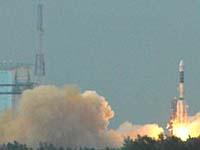
 India’s maiden lunar mission Chandrayaan-1 is set to lift off on Oct 22 early morning from the Satish Dhawan Space Centre at Sriharikota.
India’s maiden lunar mission Chandrayaan-1 is set to lift off on Oct 22 early morning from the Satish Dhawan Space Centre at Sriharikota.It is a time to rejoice and history will be made because India is finally entering the space age by sending its first ever lunar mission within two weeks. India’s maiden lunar mission Chandrayaan-1 is set to lift off in the early morning hours of October 22 from the Satish Dhawan Space Centre at Sriharikota, about 90km from Chennai, a top space agency official has said.
Indian Space Research Organisation (ISRO) director S. Satish said, “The tentative launch date is Oct 22 though the window will be kept open till Oct 26. Depending on the weather, we plan to launch the lunar spacecraft (Chandrayaan) around 6.30 a.m. IST.”
Built at ISRO’s satellite centre, this 1,380 kg spacecraft will be carried into a lunar orbit by a specially designed 320-tonne Polar Satellite Launch Vehicle (PSLV-C11), with six strap-on propellants weighing 12 tonnes each.
“The formal countdown will begin 50 hours before the launch in the early hours of Oct 20. All going well and weather permitting, the final countdown will begin hours before the actual launch on Oct 22”, S. Satish added.
The spacecraft is currently in the stages of being integrated with the PSLV rocket at the SHAR launchpad, situated off the Bay of Bengal in Nellore district of Andhra Pradesh. “All systems and instruments will be checked and tested for operational purposes. The spacecraft will orbit around the moon at an altitude of 100 km to map the topography and the mineralogical resources of the lunar soil”, S. Satish said.
Costing a cool Rs 3.9-billion, Chandrayaan-1 has 11 payloads, including five from India and six from the US, Europe and Bulgaria. It will also carry a moon impact probe payload to demonstrate and test the technology needed for soft-landing on the moon’s surface in subsequent missions.

Be the first to comment